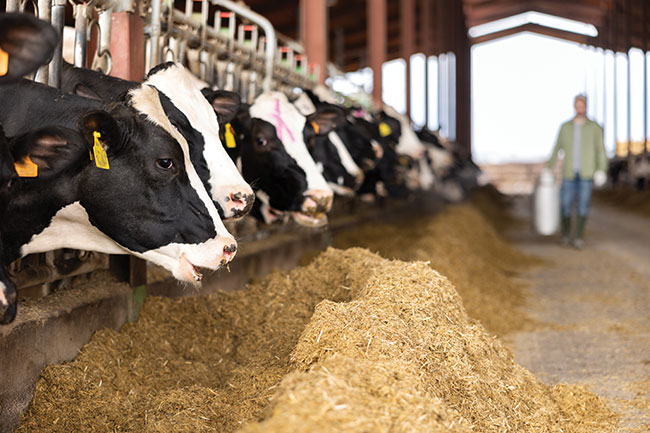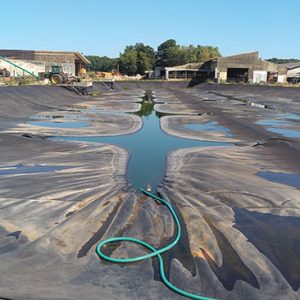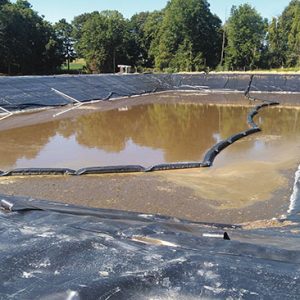
Features
Environment Protection
Protection
Mitigating methane from manure
Diet and storage management can make a difference and protect the bottom line.
November 18, 2022 by James Careless
 Photo: © JackF / adobe stock
Photo: © JackF / adobe stock The dairy and beef industries are under a lot of pressure to reduce their greenhouse gas emissions. Whether it’s through fertilizer usage – a contentious issue in Canada – or the methane produced from cow manure, livestock industries have been under the microscope and have been challenged to mitigate emissions, all while keeping the bottom line secure.
Fortunately, research has revealed new insights and has introduced ways for producers to reduce such emissions, which can make a significant difference to the environment. Some of these methods can even make cow production more profitable. Two key ways of reducing greenhouse gases on a dairy farm are by managing cattle diet and manure storage.
Reducing emissions through diet management
Manure produces methane gas, while the food eaten by cows produces manure. Theoretically, it should be possible to reduce methane emissions by changing their diets, while taking care not to deprive them of the nutrients they need for optimal productivity.
Thankfully, this methane reduction approach is more than just theory: It is fact. “We’ve been doing a lot with the environmental impact of the dairy herds and changing feeding management to improve the efficiency of nutrient use and decrease emissions to the environment of nitrogen phosphorus ammonia and methane,” says Larry Chase. Chase is a professor emeritus of dairy nutrition at Cornell University in Ithaca, NY. “Basically, it’s just a matter of putting together all the little pieces we know about their food including the quality ratio, formulation [and] daily feed.”
One of the simplest yet most effective ways to reduce methane emissions through food management is “to make sure we’re not overfeeding nutrients to cows relative to their actual requirements,” says Chase. “For example, if we’re feeding protein at 10 percent higher than the requirement, can we reduce it to five percent higher without affecting their milk production and quality? In most cases, the answer is yes. So we’re just trying to minimize the range of oversupply of nutrients to cattle. Now you always want to be just a touch over for a safety margin, but we want to reduce the size of the safety margin.”
Cornell University has formulated this approach, along with other methods for optimizing cattle nutrition and waste management, into a software program known as the Cornell Net Carbohydrate and Protein System (CNCPS). As explained online at https://cals.cornell.edu/animal-science/outreach-extension/publications-resources-software/cncps, the CNCPS program can help farmers customize their herd’s feed mix to deliver desirable levels of energy, metabolizable proteins, amino acids and mineral requirements for optimal maintenance, tissue deposition, and milk synthesis. It can also help them predict:
- The intake and ruminal degradation of feed carbohydrates, protein fractions, and microbial growth;
- Rates of intestinal digestion and excretion;
- The metabolism of absorbed energy, protein, and amino acids in their cattle’s feed; and
- The nutrient excretion and feed requirements of individual cows and the entire herd, which can be altered to reduce methane emissions.
According to Chase, the CNCPS can make a real contribution to reducing bovine methane emissions. “In most of our field studies, we can reduce emissions anywhere from five to 20 percent depending on how far above the herd’s nutritional requirement a farmer is when they start this program,” he says.
Adopting the CNCPS for feed management isn’t the only option available to cattle farmers. “A farm can hire their own nutritionist, or a group of smaller farms can hire one to work across farms,” says Jennifer Wightman, a senior extension associate in Cornell’s school of integrative plant science soil and crop sciences section. “A nutritionist can help farmers take advantage of forage quality and create mixed rations for different stage animals to optimize their rumen’s well-being. A well-balanced rumen will work more efficiently – produce more milk with less feed – and generally produce less methane. Farms can also minimize the protein and phosphorus levels to reduce nitrogen and phosphorus impact on the watershed.”
Better diet management is definitely good for the environment, and good for the bottom line as well. “Estimates on pilot farms found a net gain between $140 and $160 per cow per year,” based on recent unpublished work by extension colleagues working with dairy farms in the Hudson Valley, says Wightman. “Managing high quality forages on farms is a great way to maximize on-farm nutrition.”
Better methane management
Even with the best dietary measures in place, manure will still produce some amounts of methane gas. This is where the “cover and flare” system approach used by Dale Stein, chair of the New York State Soil and Water Conservation Committee and a “semi-retired” dairy farmer working on the multi-generational Stein Farms in LeRoy, NY can make a further difference. The genius of this system is that it covers and captures the methane gas being produced by manure for disposal by direct burn-off (hence the term “flare”), or by using that gas as a free fuel for other purposes.
In the cover and flare system, “a 60 millimeter thick plastic layer is stretched over the top of the manure storage area when it is maybe only a quarter full,” says Stein. “A trench is dug all the way around the area, with the cover being cemented into that trench so no gas can escape.”
In warm weather, when the manure decomposes and methane is produced, the gas is captured from under the cover using a perforated tube line. “That line is connected all the way around the surface,” he explains. “It travels underground to a flare about a hundred feet away from the manure storage area. The flare is a stainless steel tube, about three feet in diameter and 14 feet high with a solar-powered, computer-controlled igniter and gas detection system. When the system detects methane being produced above a threshold of so many cubic feet per minute, the computer makes the igniter flash and burn the gas off.”
In New York State, methane tends to be produced by manure cover and flare systems from early July to early November. According to Stein, his burn-off system will run “nonstop through that whole period at about 1500 degrees Celsius, with a foot tall flame just ripping inside the flare stack.”
The only downside: when burned, methane turns into CO2, which is another greenhouse gas. However, CO2 is less damaging to the environment than methane, so producing it is at least an improvement. As well, it is possible to use the methane being produced by the manure to heat water and provide heat to barns, rather than just burning it off via a flare stack.
Dale Stein’s farm has hired a team of designers to create a hot water heating system that could use methane as fuel. “We’re hoping that sometime this winter they’ll have that figured out,” he says. The goal is to have a pumping system attached to the manure storage area that will pump the methane into propane tanks on wheels. These tanks would then be driven to the farm’s milk house, “which uses an enormous amount of 170 degree water to wash everything. Doing this with methane would allow us to eliminate our current diesel-fuelled heating system, which is backed up by propane.”
Meanwhile, the manure within the storage area will still be removed as needed to fertilize this farm’s corn fields. The Stein family pushes liquified manure vertically into the soil using the knife injection system, rather than just broadcasting it over the earth’s surface. “Knifing allows you to save the manure’s nutrients, with very little evaporating away,” says Stein. “And by doing that, we reduce our cost of manmade fertilizer by 90-plus percent.”
By using dietary and manure management measures, it is possible for cattle farmers to significantly reduce their herds’ methane emissions. These approaches can reduce the industry’s contributions to climate change, and give it a defensible moral position, should complaints ever come in. •

